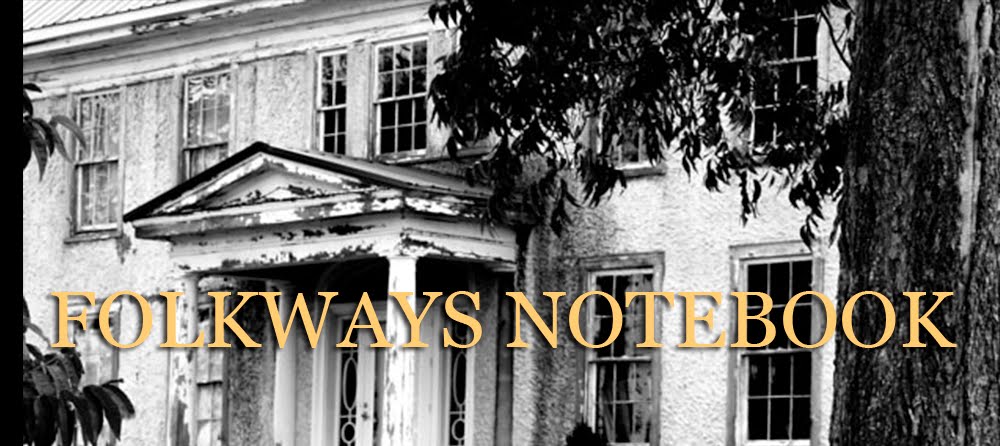Tuesday, December 29, 2009
VERNACULAR ONE-PEN LOG CABINS -- AGED AND WORN
On this day I hesitated to walk on the open private land. I always feel one needs to obtain permission. If one is granted they should ask if there is a vacated open well site or perhaps unfriendly dogs that might descend on them.
When I viewed the dwelling from the road it was difficult to decipher the construction details that usually give hints as to the possible date it was built.
So I used my photo I took of the place to determine some of the construction details. I could make-out that it had half-dovetailed notching and secondly that it did not have an outside chimney on the gable end. At least the gable end that could be seen from the road. . Perhaps it had one but was located out of my view. What I did see was a metal smoke stack poking out of the roof near the ridge line which meant that a metal stove had been used for heat. I believe this might be a log built around the late 1800s. Not sure. A close examination of the log would either dispel this assumption or verify it.
Another abandoned property was found near the town of Paint Lick on Gillison Road in Madison County, Kentucky. It has round-log corner notching with an addition. The smaller unattached log building appears to be an outhouse. No one was available to ask permission to walk the land. Round log was common in both the 1800s and the early 1900s. The early round log cabins left the bark on while the later round log dwellings were skinned of their bark.
Historically Kentucky had large inventories of log buildings. Today log dwellings are sparse on the landscape. It seems that most house historians believe that these types of dwellings hay-day was from the late 1700s through the early 1900s. This would put most of those still extant on the land in Kentucky about 100 years of age or older.
Information source for this post: Kentucky Folk Architecture, Montell and Morse.
Monday, December 21, 2009
FANTASTIC BIOLOGICAL SOURCE ON THE WEB
 PAGE SOURCE: HANDBOOK OF FROGS AND TOADS OF THE UNITED STATES AND CANADA
PAGE SOURCE: HANDBOOK OF FROGS AND TOADS OF THE UNITED STATES AND CANADAby Anna Allen Wright and Albert Hazen Wright, Professor of Zoology, Cornell University, 1932
Now maybe everyone knows about this source but me, but I was sure glad to have discovered it today. I was perusing one of my favorite magazines, UTNE, when this article appeared, The Encyclopedia of Life, which was the name of an internet site. Apparently this internet idea was a dream of E. O. Wilson. His idea, in his words were, Imagine an electronic page for each species of organism on earth .
Wilson's dream is now a website called The Encyclopedia of Life which allows all 1.8 million species known on earth their own page!
I turned to my computer and typed in its address and was taken to a registration page. After an easy registration I was able to take a test run of the site. I just took "frogs" as an example to search for and ended up knowing just about all that I could possibly think to ever know about frogs.
The photo at the top is just the tip of the iceberg of the knowledge represented and available on the site. You can open old documents and books and page through them. There is much more but I will let you check it out for yourself if you haven't already.
Saturday, December 19, 2009
BEAUTIFUL PRE-SOLSTICE SNOWY DAY
I hear on my radio that a huge snow storm is rushing up the eastern coast and will reach New York sometime this afternoon as a blizzard. Perhaps it is mother nature's way of churning everything to a halt and saying, " stop shopping, you're using up my resources."
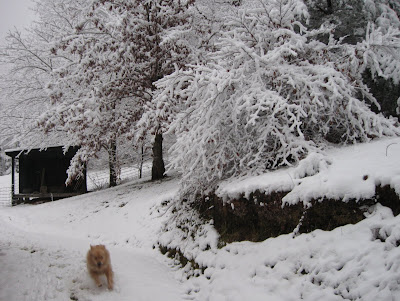 SAL GALLOPS CRAZILY THROUGH THE THREE INCHES OF SNOW
SAL GALLOPS CRAZILY THROUGH THE THREE INCHES OF SNOWWhat a delight it is to experience the sheer joy snow brings to Sal and Lil.
 LIL AND SAL COMPLETELY WEAR DOWN THE SNOW AS THEY PLAY
LIL AND SAL COMPLETELY WEAR DOWN THE SNOW AS THEY PLAYAfter a hard romp in the snow their eyes shift toward me. They tell me its time to eat.
Wednesday, December 16, 2009
A MOVING PHILOSOPHY
Sunday, December 13, 2009
OLD RURAL KENTUCKY FENCING
 EARLY 1800s PROPERTY WITH ORIGINAL DRY STACKED LIMESTONE FENCING
EARLY 1800s PROPERTY WITH ORIGINAL DRY STACKED LIMESTONE FENCINGDry stacked fencing has a history reaching back into ancient times. In Kentucky its history of construction can travel as far back as the late 1700s -- believed to be built by slaves and/or Irish immigratnts. Kentucky's natural limestone beds have provided the resources to construct the beautiful fences. Today there is an effort to maintain what still exists through training by the Dry Stone Conservancy. Also an excellent researched book by Carolyn Murray-Wooley presents a fascinating history of the early years of building Kentucky's limestone fences. Unfortunately, of the hundreds of miles of fencing of this type in the state, much are in need of repair. It takes knowledgeable people to maintain them of which the Dry Stone Conservancy is working toward.

Source: city.data.com
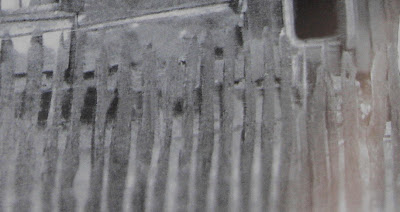 1800s PRIMITIVE COUNTRY PICKET FENCING
1800s PRIMITIVE COUNTRY PICKET FENCING 1931 MORTAR AND LIMESTONE MASON BUILT FENCING
1931 MORTAR AND LIMESTONE MASON BUILT FENCING REMAINING SECTION OF OLD PICKET FENCE ON ABANDONED PROPERTY
REMAINING SECTION OF OLD PICKET FENCE ON ABANDONED PROPERTYThursday, December 10, 2009
MERRY CHRISTMAS FROM FANNIE SCOVELL
 Miss Fannie Scovel sent this card out to wish the receiver a Merry Christmas and happy New Year in the early twentieth century. She placed her words in pencil, "with my flowers'" at the top of the message. The bottom is her simple signature Fannie Scovel.
Miss Fannie Scovel sent this card out to wish the receiver a Merry Christmas and happy New Year in the early twentieth century. She placed her words in pencil, "with my flowers'" at the top of the message. The bottom is her simple signature Fannie Scovel.Photo postcards span the early twentieth century and open up the world to the folkways of the people. The back of photo postcards have a regular postcard backing with a space for message, stamp, and date and town postmark. This sparse information along with the photo can tell us about housing stock, clothing, hairstyles, interests, pets, cars, and other sorts of clues. They are windows to this early era.
Collecting them can be interesting and they can still be found at reasonable prices. I have had this Fannie Scovel photo postcard for many years. Personal clues, to this early 1900s elder woman's passion, are roses, creative gardening, living in a middle class neighborhood, and loving hats. She probably lived alone as no family is mentioned. Other clues can be picked out from this postcard.
Picture postcards were taken by the common people, not studio produced, so they are true reflections of the time. For more information click here.
Tuesday, December 8, 2009
WINTER SOLSTICE 3000 YEARS AGO
Photo: knowth.com
Let's understand why so many people desire to experience the solstice at the Newgrange burial mound. Little is known of its history. Here's what we do know. It dates back to the New Stone Age of the Neolithic period. The Neolithic period was the beginning of agriculture as we know it in our civilization. Also, at this time, rituals and burials became a part of life. Art flourished. Not knowing about the how, when, and who of the place seems to set it into the realm of the mystical. Especially, because the entrance to the mound has an opening right above it, like a door transom, built of stone, where the solstice sunlight shines into the interior passageway to light the central chamber. Only at the time of Winter Solstice does this happen. It's architecture is very sophisticated.
It is thought that the Winter Solstice was perhaps significant in the life of the ancients as it was a sign of birth and renewal.
This year we realize the solstice on Monday, December 21st. Current recognition for some is a time of contemplation and wonderment, and for others a time of ritual and festivities.
The below YouTube video was produced by tubelookjohn. He captures the sense and spirit of Newgrange.
Monday, December 7, 2009
WORLD COMMUNITY AND CLIMATE CHANGE
Unless we combine to take decisive action, climate change will ravage our planet, and with it our prosperity and security. The dangers have been becoming apparent for a generation. Now the facts have started to speak: 11 of the past 14 years have been the warmest on record, the Arctic ice-cap is melting and last year's inflamed oil and food prices provide a foretaste of future havoc. In scientific journals the question is no longer whether humans are to blame, but how little time we have got left to limit the damage. Yet so far the world's response has been feeble and half-hearted.
Climate change has been caused over centuries, has consequences that will endure for all time and our prospects of taming it will be determined in the next 14 days. We call on the representatives of the 192 countries gathered in Copenhagen not to hesitate, not to fall into dispute, not to blame each other but to seize opportunity from the greatest modern failure of politics. This should not be a fight between the rich world and the poor world, or between east and west. Climate change affects everyone, and must be solved by everyone.
The science is complex but the facts are clear. The world needs to take steps to limit temperature rises to 2C, an aim that will require global emissions to peak and begin falling within the next 5-10 years. A bigger rise of 3-4C — the smallest increase we can prudently expect to follow inaction — would parch continents, turning farmland into desert. Half of all species could become extinct, untold millions of people would be displaced, whole nations drowned by the sea. The controversy over emails by British researchers that suggest they tried to suppress inconvenient data has muddied the waters but failed to dent the mass of evidence on which these predictions are based.
Few believe that Copenhagen can any longer produce a fully polished treaty; real progress towards one could only begin with the arrival of President Obama in the White House and the reversal of years of US obstructionism. Even now the world finds itself at the mercy of American domestic politics, for the president cannot fully commit to the action required until the US Congress has done so.
But the politicians in Copenhagen can and must agree the essential elements of a fair and effective deal and, crucially, a firm timetable for turning it into a treaty. Next June's UN climate meeting in Bonn should be their deadline. As one negotiator put it: "We can go into extra time but we can't afford a replay."
At the deal's heart must be a settlement between the rich world and the developing world covering how the burden of fighting climate change will be divided — and how we will share a newly precious resource: the trillion or so tonnes of carbon that we can emit before the mercury rises to dangerous levels.
Rich nations like to point to the arithmetic truth that there can be no solution until developing giants such as China take more radical steps than they have so far. But the rich world is responsible for most of the accumulated carbon in the atmosphere – three-quarters of all carbon dioxide emitted since 1850. It must now take a lead, and every developed country must commit to deep cuts which will reduce their emissions within a decade to very substantially less than their 1990 level.
Referenced from Worldchanging Bright Green
Sunday, December 6, 2009
BEAR MOUNTAIN WILDLIFE HABITAT
This fall I established my place as a National Wildlife Federation Certified Wildlife Habitat area. I feel I have a commitment to the land, plants and the critters to provide, as much as I am able, an undisturbed place.
 BIRDS NESTS, CATERPILLARS AND MOTHS GUIDES
BIRDS NESTS, CATERPILLARS AND MOTHS GUIDESbirds' nests book great to use after the leaves have fallen or the field has died back
Too many good books to list here. However, I will mention a few that are fine guides that I found great for becoming acquainted with mother nature. See list at the bottom of this post. Also there are so many nature blogs with terrific information. Check out the Nature Blog Network for a list plus check out my "good blogs" section on my sidebar.
Become a life long learner about our natural world. Reserve an area for wildness.
List of above books below:
2. Insects; Peterson First Guides, Christopher Leahy.
3. Caterpillars; Peterson First Guides, Amy Barlett Wright.
4. A Field Guide to Animal Tracks; Peterson Field Guide, Olaus Murie.
5. Newcomb's Wildflower Guide, Lawrence Newcomb.
6. Weeds; Guardians of the Soil, Joseph A. Cocannouer.
7. Eastern birds' Nests; Peterson field Guides, hal H. Harrison.
8. Discovering Moths; Nighttime Jewels in Your Own Backyard, John Himmelman.
9. Non-Flowering Plants; A Golden Nature Guide.
10. Winter Tree Finder, Mary Theilgaard Watts and Tom Watts.
11. Dragonflies and Damselflies, Steve Gordon and Cary Kerst.
ENJOY!
Saturday, December 5, 2009
APPALACHIAN SNOWFALL
 A view from my front porch -- as well as my window behind my computer. I'm located on a ridge of Bear Mountain upon the tableland of the Appalachian Plateau. Yesterday, it was sunny and the birds in the yard were actively feeding. Today they are inactive. What is active are my dogs running through the snow with white tufts of snow on their noses. My silver maple stands as a steward of the small valley below. Its buds in place but dormant until the spring. All is well.
A view from my front porch -- as well as my window behind my computer. I'm located on a ridge of Bear Mountain upon the tableland of the Appalachian Plateau. Yesterday, it was sunny and the birds in the yard were actively feeding. Today they are inactive. What is active are my dogs running through the snow with white tufts of snow on their noses. My silver maple stands as a steward of the small valley below. Its buds in place but dormant until the spring. All is well.
Thursday, December 3, 2009
GROWING OLDER, THINKING AND WRITING A LIFE
 As my age turns to seventy years in 2010, I am finding time for reflections of the life I have lived. My reflections to be scribbled onto blank pages. How do I begin the process?
As my age turns to seventy years in 2010, I am finding time for reflections of the life I have lived. My reflections to be scribbled onto blank pages. How do I begin the process?A large plastic envelope filled with old photos could possibly be a place to start. Perhaps they would jump-start images along with mind memories. Examining each one carefully could awaken my personal landscapes...why, when, how, who, and where it was taken. You could call it the bones of a memory. Of course each photo will be but a piece of my life, yet they can be woven along with other scraps to compose a life tapestry.
 Why photos? Why not sit down and just start writing memories. Because, I feel that using both memory and vision together can produce a closer proximity to the real life. I plan to title my writings, Making a Childhood. Although one reading of Making a Childhood will not provide a full perspective of a young life, the gaps can produce interpretations open to the reader.
Why photos? Why not sit down and just start writing memories. Because, I feel that using both memory and vision together can produce a closer proximity to the real life. I plan to title my writings, Making a Childhood. Although one reading of Making a Childhood will not provide a full perspective of a young life, the gaps can produce interpretations open to the reader.Why write a story of one's life? Especially a common life. Several reasons. Haven't you at some time wished you knew the true story about some family member but knew it was too late as they had passed away. Or, you have a desire to leave a textual footprint for future generations? And if not any of the last two reasons, perhaps for yourself to understand a life one has lived.
 We all live and we all die. I do not believe that we are on earth for any general purpose -- only for the opportunity to live a good life if possible. We are given the tools to explore this opportunity in whatever capacity we desire. We can be caught in traps all along the way and sometimes those traps are our demise. We can travel down any one or several paths during our jouney and hopefully we can use our joy to survive in the present moment.
We all live and we all die. I do not believe that we are on earth for any general purpose -- only for the opportunity to live a good life if possible. We are given the tools to explore this opportunity in whatever capacity we desire. We can be caught in traps all along the way and sometimes those traps are our demise. We can travel down any one or several paths during our jouney and hopefully we can use our joy to survive in the present moment.So with this short discourse, I will proceed or better yet, "dive" into my past life with, of course, bias. Reviewing your life can be a clearinghouse as well as perhaps producing a great story. Each of us has a story or stories filled with the emotions that our mind produces. However, we are the captain of those emotions. We steer the struggles and smiles of our life.
Stories are our connections to life.
Sunday, November 22, 2009
Tuesday, November 17, 2009
BLUEBIRDS, PURPLE MARTINS, BIRDHOUSES, A THOUGHTFUL MAN
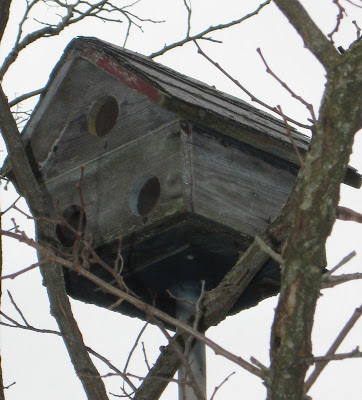 The morning sky was laden with overcast clouds signaling a storm was more than likely on its way. I was in my truck on my way to talk with an interesting man by the name of Caroll Cain, a maker of bird houses. Not birdhouses for his home but for his full time worksite. And not just any style of birdhouses -- mostly for purple martins.
The morning sky was laden with overcast clouds signaling a storm was more than likely on its way. I was in my truck on my way to talk with an interesting man by the name of Caroll Cain, a maker of bird houses. Not birdhouses for his home but for his full time worksite. And not just any style of birdhouses -- mostly for purple martins.Mr. Cain works at a trash transfer station. How this works is that locals bring their trash to this place to load into large metal containers that are eventually hauled away to a land fill. The landscape of the transfer station is serene and was once an old large farm site. Rolling acres now lay fallow with pods of trees emerging on knolls. Here in this picturesque place, Mr. Cain has created a village of sorts for purple martins and eastern bluebirds and other assorted birds. But mostly purple martins and bluebirds.
 SKY HIGH PURPLE MARTIN HOUSES
SKY HIGH PURPLE MARTIN HOUSESCaroll Cain is a man of 72 years and has spent the last 17 years working at the station. We began talking about his birdhouses as the impending storm headed directly toward us. but it held off long enough so that I was able to hear an intriguing story from Mr. Cain.
About ten years ago he noticed purple martins hanging out on the overhead electrical lines near his trailer office at the station. He thought that he would make a home for these birds and began to pick out pieces of trash that people would bring in for disposal. Like pieces of plywood, old wood and other materials that could be used to construct birdhouses. That winter, in his spare time, he worked on constructing a purple martin house. He has since built all the many houses around his work-site except for one commercial purple martin house -- all from recycled trash.
His first season of placing his homemade martin house on a pole was successful. The martins made the new birdhouse their home and have been coming back every season for the past ten years. Also, bluebirds have joined in the bird village atmosphere thanks to Mr. Cain who made and placed birdhouse boxes for them. He also built a few regular birdhouses open to any species.
Apparently Mr. Caroll's fascination with the purple martins was contagious. It led to other folks appreciation of his birdhouses. He began making birdhouses for people using the recycled materials. One man requested 25 bird houses.
 ORANGE BLUEBIRD NESTING BOX ON TOP OF POST WITH 3-HOLE PURPLE MARTIN BELOW
ORANGE BLUEBIRD NESTING BOX ON TOP OF POST WITH 3-HOLE PURPLE MARTIN BELOW PAINTED BLUE, A HOME THAT IS ALWAYS OPEN TO ANY TAKER
PAINTED BLUE, A HOME THAT IS ALWAYS OPEN TO ANY TAKERWITH A BLUEBIRD NESTING BOX LOWER IN THE TREE
I did a little research on purple martins and found that according to a 2001 study that their populations are declining in the northern part of the U.S. while remaining stable or increasing in the south.
A recent migration pattern study found that purple martins migrate to the Amazon Basin and back. Scientists followed two female martins from Pennsylvania -- 9,300 miles to and from the Amazon basin -- that's about a 4,650 one way trip for the birds. The martins were recorded as flying about 358 miles a day during migration.
Mr Cain's purple martin houses, for the most part, are three-holed and can be found on poles at various heights. No longer making birdhouses, he has influenced many that come to the transfer station about the role of birds plus how one can use recycled materials creatively.
The martins had left in August. Now it was time for me to leave as it had started to rain. As I drove home in the rain I was reminding myself that one person's actions can make a difference.
Sunday, November 15, 2009
OLD VERNACULAR --STOCKERS GROCERY AND GENERAL MDSE -- UPLAND SOUTH
Old general stores, similar and not so similar in construction, are scattered and can be found sometimes within miles of each other. Their time of life was before box stores and fast cars. At one time close proximity to the population being served was the important factor.
I've always been interested in country general stores. At one time they played multiple roles in their community, both as goods and service providers plus a community hub. In many areas in Kentucky structures still exist but are either in an out-of-business/state-of-decline or have been turned into a newer type of small country business or homestead. Very few remain as general stores.
They were where you met your neighbors, discussed local events, sometimes did a little horse trading, and picked up your mail. In the photo below a sign on the old store tells us it might have also served as an official wildlife check station.
The last name of the store was Stokers, a prior name is shadowed underneath the black letters. I feel the siding is unusual. It is applied to the sides of the building in metal sheets rather than individual squares. The roof is metal and worn to a rusty brown. The store shows no sign of life.

 CLOSE-UP OF UNUSUAL PRESSED METAL SIDING ON STOCKER STORE
CLOSE-UP OF UNUSUAL PRESSED METAL SIDING ON STOCKER STOREUnusual window awning -- made out of the siding.
I hope to post more about general stores in the future.
Saturday, November 7, 2009
KENTUCKY'S RURAL CHURCH ARCHITECTURE, 1800s
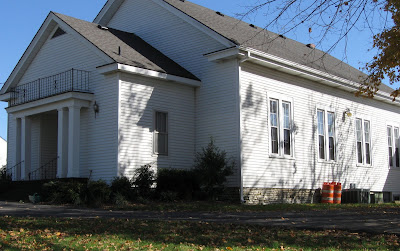 MOUNT TABOR BAPTIST CHURCH
MOUNT TABOR BAPTIST CHURCH PAINT LICK UNITED METHODIST CHURCH
PAINT LICK UNITED METHODIST CHURCH OLD MULKEY MEETING HOUSE
OLD MULKEY MEETING HOUSE KIRKSVILLE CHRISTIAN CHURCH -- EST. 1849, CURRENT STRUCTURE -- 1878
KIRKSVILLE CHRISTIAN CHURCH -- EST. 1849, CURRENT STRUCTURE -- 1878 KIRKSVILLE CHRISTIAN CHURCH -- REPLACED STAIN GLASS 1995
KIRKSVILLE CHRISTIAN CHURCH -- REPLACED STAIN GLASS 1995Paint Lick Presbyterian church was founded in 1784. It began its life in the church's cemetery. following came a second church in 1830 and the present church in 1875. The 1875 being the popular style of the time, Gothic Revival.
These few churches presented here are a sampler of the many found in Kentucky country. As I find more with unusual pasts or parts I will include them in a future post. These small churches were often the life blood of the community in the 1800s when transportation was primitive as was communication outside the area.
Church cemeteries are often associated with country churches. I remember going to my grandmother's funeral at a country church in Ohio. I was about six. Her coffin was in the church for the service and then taken outside only perhaps a few feet, and then had her burial right then and there. A large gaping hole had been dug for her coffin.. She was lowered into the ground while friends and family stood around the gravesite. She was lowered by a couple men using thick long ropes. Then the men took shovels and started to throw dirt back in the hole after the coffin had been completely lowered. That was the old country way in the past.
The churches in this post all have active parishioners except for the Mulkey Meeting House.
